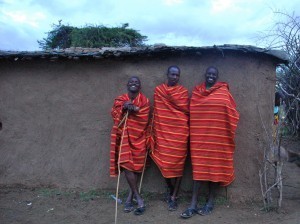Lisa Niver's Blog: We Said Go Travel, page 435
December 31, 2013
Seven New Years Together: Love, Celebrate, Grow
 Arriving to the upscale restaurant dressed up and excited to celebrate New Year’s Eve in Puerto Rico, we were shocked when the maître d’ blurted, “You are late but we will seat you.” Our expectation was that our 8:00 p.m. dinner would lead to hours of frivolity in Old San Juan; however, from the moment we left our hotel, it became clear we were wrong. We had selected our accommodation based on its proximity to a local salsa club. Yet when we departed our hotel, we noticed the nightclub was locked up like a jail. Now the restaurant was upset we were 15 minutes late. They served us quickly and made sure they were able to close promptly at 9:00 p.m. This dining experience was hardly the leisurely time we had anticipated from where to begin our night’s festivities.
Arriving to the upscale restaurant dressed up and excited to celebrate New Year’s Eve in Puerto Rico, we were shocked when the maître d’ blurted, “You are late but we will seat you.” Our expectation was that our 8:00 p.m. dinner would lead to hours of frivolity in Old San Juan; however, from the moment we left our hotel, it became clear we were wrong. We had selected our accommodation based on its proximity to a local salsa club. Yet when we departed our hotel, we noticed the nightclub was locked up like a jail. Now the restaurant was upset we were 15 minutes late. They served us quickly and made sure they were able to close promptly at 9:00 p.m. This dining experience was hardly the leisurely time we had anticipated from where to begin our night’s festivities.
Our first year together as a couple was not ending with a bang. We had survived a strange weekend away in San Luis Obispo and a wonderful summer voyage to Fiji and Vanuatu. Nevertheless, Old San Juan was locked up and dead, a lackluster end to 2007. We were informed that an accidental shooting in the old town amidst a giant party that occurred a few years back transformed the zone as now the locals stay home with family. We could have attended one of the prepaid large hotel parties but it isn’t our style and we never would have imagined that Old San Juan would have been closed.
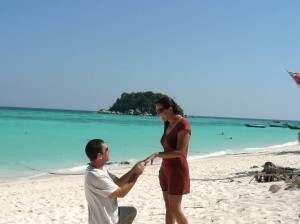 A year later as 2008 came to an end, we were six months into our yearlong sabbatical and George secretly had intended to propose to me at Borobudur but I was ill. Roaming Yogyakarta’s streets, we attempted to stay awake until midnight but my illness prevailed, leading once again to a fairly lame New Year’s Eve. At this time, I sent out monthly newsletters, shared photos, and maintained a detailed travel diary.
A year later as 2008 came to an end, we were six months into our yearlong sabbatical and George secretly had intended to propose to me at Borobudur but I was ill. Roaming Yogyakarta’s streets, we attempted to stay awake until midnight but my illness prevailed, leading once again to a fairly lame New Year’s Eve. At this time, I sent out monthly newsletters, shared photos, and maintained a detailed travel diary.
2009 was full of surprises including an underwater engagement in Koh Lipe, months of traveling Asia, a wedding at Casa Del Mar, and a fantastic honeymoon in the Cook Islands. The New Year’s Eve beach party on Rarotonga was entertaining, a brake from the disappointing end of year celebrations. During the Fall, we used our journals to create a manuscript entitled, He Said, She Said: Adventures in Asia; this tale would gather dust for years while we lived in Los Angeles with busy 9-5 jobs.
In order to jumpstart our eventual book release, we would need a platform. Therefore, before we traveled to Sri Lanka during the summer, WeSaidGoTravel (WSGT) was born as a blogger site in 2010. To end the year, we had our first CouchSurfing experience, an amazing New Years Eve party that included a launch at an oceanfront condo where sixty travelers from over two-dozen countries mingled while consuming cocktails. The group then entered an open-air bus where a salsa band performed live in Cartagena. Next the bus stopped in front of a castle for 45 minutes where we gyrated to live music. Promptly, we departed to Long Beach, a centrally located discotheque, eventually wandering toward the old town where walls of people partying, we enjoyably celebrated our first wedding anniversary in style.
During 2011, WSGT added a website on Weebly and our first events were held: A lecture dubbed Uncovering Jewish Morocco, and hosting of Meet Plan Go in Los Angeles. Our second year wedding anniversary was celebrated in Memphis with excellent live Blues and a delicious barbeque at Rendezvous. Then we met the family in New Orleans to depart on a Caribbean cruise before rejoicing New Year’s Eve with fireworks over the waterfront in New Orleans.
 New Year’s Eve 2012 in Goa, IndiaAfter three years employed in Los Angeles, we again hit the road full time. Before leaving on our second sabbatical in 2012, WSGT was converted to a WordPress site with the intention of turning the website into a contender in the blogging world while we traversed Asia. The year-end was spent in Goa, India, a portion of the three months we traveled the sub-continent. Partying with new friends on Palolem beach is where the new-year festivities arrived complete with fireworks.
New Year’s Eve 2012 in Goa, IndiaAfter three years employed in Los Angeles, we again hit the road full time. Before leaving on our second sabbatical in 2012, WSGT was converted to a WordPress site with the intention of turning the website into a contender in the blogging world while we traversed Asia. The year-end was spent in Goa, India, a portion of the three months we traveled the sub-continent. Partying with new friends on Palolem beach is where the new-year festivities arrived complete with fireworks.
Our sabbatical year evolved. We realized this transformation in the Philippines when a manager at a hotel asked, “How long have you been away.” When we responded, “Fourteen months,” she laughed and added, “But a year only has twelve months.” George facetiously replied, “We aren’t good at math.” People assume that we are traveling on a gap year but one-year wasn’t enough. WSGT notably expanded to a Google page rank 5, monthly traffic has doubled, and three annual travel-writing contests have markedly augmented site engagement with over 500 writers participating from over thirty-three countries.
As we continued on our journey, we were rewarded in August 2013 by being added to the Top 100 Travel Blog list hosted by Nomadic Samuel. Closing out the year and our fourth wedding anniversary, we expanded our horizons by housesitting in Langkawi, Malaysia. We had a lovely dinner with our toes in the sand for our anniversary at Pantai Cenang and look forward to more revelry to bring in the New Year. Soon we will be celebrating the day we met nearly seven years ago. It has been an incredible amazing fantastic voyage and we cannot wait to see what happens in 2014!
WATCH: Traveling in Sin, Video Book Trailer
About the Authors: Lisa Niver Rajna and George Rajna are co-authors of Traveling in Sin and co-founders of We Said Go Travel. They are accomplished writers, speakers and travelers who are members of the Traveler’s Century Club, a unique travel club limited to travelers who have visited one hundred or more countries. They left Los Angeles in July 2012 and are currently housesitting in Langkawi, Malaysia.
This article first appeared in the Huffington Post. HAPPY NEW YEAR!
The post Seven New Years Together: Love, Celebrate, Grow appeared first on We Said Go Travel.
Italy: Grazie, Villa Lante, Grazie Bagnaia
Grazie, Villa Lante, Grazie, Bagnaia!
Esther Kane Meyers
I drove straight from the Rome airport to Bagnaia and the Villa Lante. I had not called ahead, but was confident that the grand Renaissance-era Villa would greet me warmly. I passed through her towering iron gates and immediately found Rosella, the art curator.
The Villa, my villa, had an art curator? I couldn’t believe it.
From my purse, I pulled out the poem I had written.
“You see, Rosella, right after the war, I was a refugee here. I have come to say ‘thank you’.”
But Rosella was already unlocking the door to the inner rooms. She led me in and wanted to know,
“Do you remember this fresco and how about that statue over there?”
What could I say to her? “I’m not sure, I don’t know, I was just a baby, too young to remember?”
A voice inside my head screamed, Rosella, this was our “Gan Eden”, our Garden of Eden. This place saved our lives!
As we returned to the courtyard, I repeated, “I brought a poem I wrote to say thank you to…. “
She interrupted, “This fountain, does it look familiar to you, Esther?”
“No. But my mother loved a certain joke fountain. Do you know where it is, Rosella?“
She looked puzzled at first and then called the gardener. He led us through a maze of manicured hedges to a walkway and then he ducked behind some bushes to turn on a hidden spigot. Suddenly, six narrowly arched jets showered us as we stood there in the midday sun.
“Rosella, this is it! My mother would say, ‘Imagine, a fountain squirting water just to make people laugh!’”
The timeless spigot rains her spray
With playful reassurance.
Revived, refreshed, we set the course
To fight for our endurance.
I continued, “Rosella, my parents were sole survivors of large families in Poland and then made it across the Alps to freedom. My twin and I were born in Florence and then, our family was brought to this ‘Garden of Eden’ turned Displaced Persons’ Camp.” My next words rolled over my tongue like sweet nectar, “I was a baby in Bagnaia, bambina a Bagnaia.” We both laughed.
In the Renaissance, this Villa was known as a class act; a lush and abundant playground for Popes and Kings. Mussolini cavorted here with his favorite mistress. Nazis headquartered here and, after the war, her whimsical statues and playful fountains hosted young Jewish refugee families like my own.
The Villa’s ancient statues
Preside like lost relations
To populate our lives for now
And calm the isolation.
By the time our family got here, the Villa’s cupboards were bare and her columns, crumbling. Mother tore apart her dresses to make diapers for us. With little food and no milk, only those who could nurse kept their babies alive.
But, ah, the gardens were indeed a “Gan Eden”! I wandered into a shady alcove where I encountered a lovely female form in stone. She was pocked and weathered, but water still gushed from her nipples down to a vessel below. This carved lady may well have buoyed Mother’s spirits, her own breasts flowing with the milk that she so desperately needed to sustain us.
A maiden fills the basin
As a mother soaks her feet.
One of stone, the other human,
Yet, their friendship is complete.
Up, up, up eroding stone terraces I climbed, up to the rose garden with its commanding view of the town. The breezes I felt and the gurgles I heard from nearby fountains might have calmed us so that Mother could get some rest too.
In the fragrance of her roses
Two sleepy babies lie,
Attired in the swaddles
Of their mothers’ poignant sigh.
Overlooking the village, I proclaimed, “Ladies of Bagnaia, I thank you. You cared for us when Mother became too weak. She came to trust you, to let you take over for a while so that she could rest. You played with us; you knit tiny sweaters and booties for us. You gave Mother the courage to believe again that, ‘Iz nokh do guteh menchen in di velt’, there are still good people in the world!”
The townsfolk of Bagnaia
Show the refugees they care.
They have so little for themselves
But even that, they share.
I finally did read my poem, my offering of thanks, to Rosella, ending with the words,
Villa Lante’s sheltering splendor
Joins with mother’s nurturing might
To bring the blessings of Bagnaia
To win survival’s fight!
We wept in each other’s arms and Rosella promised to translate my poem and add it to Bagnaia’s archives.
My parting word to her was one that Mother must have said many times during our stay here.
It may well have been my first spoken word.
“Grazie”
About the Author: Esther Kane Meyers, born to two holocaust survivors living in a DP camp in Italy at the close of the war, is soon to publish the first volume of her memoir.
Thank you for reading and commenting. Please enter our next Travel Writing competition and tell your story.
The post Italy: Grazie, Villa Lante, Grazie Bagnaia appeared first on We Said Go Travel.
December 30, 2013
Chefchaouen, Morocco: The Television of Nomads
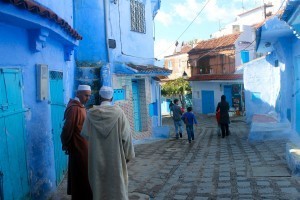 We pay the ferryman with a coin into his mouth and he whizzes us across the Strait of Gibraltar, across waters of indigo and cerulean collapsing into jade, a white foam skirt trailing behind us. At the crest of every wave I release a breath—exhaling my Western anxieties, the weights I carry at home in Prague, where I was studying at the time, those obligations and fears of the unknown. None of that matters in Morocco. And this feeling inside of me spreads throughout my body like a drunken warmth, a pocket full of ashes–the anticipation, it tingles. I thrust my face in the wind. My eyes water and I exalt the sun.
We pay the ferryman with a coin into his mouth and he whizzes us across the Strait of Gibraltar, across waters of indigo and cerulean collapsing into jade, a white foam skirt trailing behind us. At the crest of every wave I release a breath—exhaling my Western anxieties, the weights I carry at home in Prague, where I was studying at the time, those obligations and fears of the unknown. None of that matters in Morocco. And this feeling inside of me spreads throughout my body like a drunken warmth, a pocket full of ashes–the anticipation, it tingles. I thrust my face in the wind. My eyes water and I exalt the sun.
My body sinks into the ferry as it descends into what seems like another world. “Down, down,” I whisper to myself, “into the lovely, dark, and deep.”
Fresh off the boat into Tangier we meet yet another sea—one of solicitors, echoing salam! bonjour! hola!, waving us into cabs, into the market place, offering to guide us to our destination (for a fee, of course). We walk past them and find our way onto the sticky seats of the Souk Bus, the only two girls without their heads covered. The bus swerves off on a curvy road and I stare out at the orange rocks, trying not to notice the turning heads with eyes that burn through me.
The bus takes us into the city of Chefchaouen, its buildings washed white and blue by the hands of Jewish refugees in the ‘30s. From a terrace we hear the Mosques calling throughout the city, singing to each other through megaphones posted on towers, the Arabic melody rising above us in the peach glow of the setting sun. Within the enclave of the Rif Mountains, the town becomes an amphitheater. I hear children playing down cobblestone hills, Moroccan women talking together as they pin up laundry, the skins of goats slapping the ground. A city of sounds. Standing at just the right place, I can hear anything.
Fes is even louder. Its medina loses us like a labyrinth, donkeys carting skins down narrow passageways, the fleshy smell of leather tanneries kept in by the rainclouds. The French man who hosted us said we were lucky to come when we did. The festival occurred a few days before our arrival, an animal slaughtered in every household. “Streets covered in blood,” he told us. The rain had washed it away.
In Marrakech, the rain wants to wash us away as well. Rain pours over the market alleys and we seek refuge in couscous tagine pots and mint tea. The square of the Jemaa el-Fna floods as shop owners scurry to collect their inventory into plastic bags, but the horn of a snake charmer never stops singing. “Insha’Alla,” I say. God’s will. Overhead, dark clouds threaten us for days until, finally, we descend further south, crossing the desert threshold into the city of Zagoura.
After zigging and zagging on the edge of the Atlas Mountains at an absurd speed we arrive in the Sahara, leaving behind the dark clouds for a transparent night sky. I had never seen the stars so clearly–the expanse of sky opened itself to us as we mount our camels and join the Berber nomads. In their turbans they play drums and castanets and sing by the camp fire, beckoning us to drum and dance with them. When we dance and sing there under the night sky surrounded by nothing but a sea of sand for miles, I am lost in the mystical present–not in my fears, not the weight of a future I have yet to establish. I crave the unknown. I crave the beauty of our camp oasis, of being truncated from all that is familiar. The rest of our party retreats to their tents, but we don’t follow. Two Berber boys walk us through the desert, outside the edges of the campsite, past the sleeping camels, sinking into sand dunes as we try to climb them. When we’re far enough, we fall onto our backs. Perched at the crest of a dune, we bury ourselves in a sand blanket, cuddled in the warmth of the day kept insulated, the night sky glimmering overhead, our breath creeping to silence in mimesis of the stark desert air.
One of the young Berbers who had helped in our burial gestures to the sky. “You, at home in America, you have T.V.’s to watch, television…artificial, right? But this,” he says, spreading his arms at the white moon, the black screen so clustered with constellations, with shooting stars, millions of light-years trapped in one singular moment of time, “this is the television of nomads.”
About the Author: Lauren West is a recent honors graduate in English from UCLA and has traveled extensively, visiting a total of twenty countries throughout her life. She is currently working for the non-profit political project Citizen Mofo, fighting the good fight, and plans to teach abroad in Asia next Fall.
Thank you for reading and commenting. Please enter our next Travel Writing competition and tell your story.
The post Chefchaouen, Morocco: The Television of Nomads appeared first on We Said Go Travel.
Entering the Tibetan plateau, China
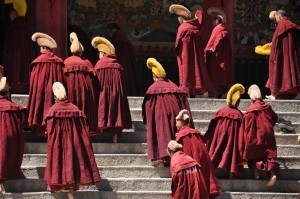 “Welcome to Tibet״ a monk wearing a dark rouge colored robe greeted us, at an alley outside Lābǔléng Sì in the city of Xiàhé. It was early afternoon, hundreds of monks just finished their prayer and lunch ritual, so most of the monastery’s streets were deserted. The low earth buildings that make up the monastery’s labyrinth gave shelter to the monks in the midday heat.
“Welcome to Tibet״ a monk wearing a dark rouge colored robe greeted us, at an alley outside Lābǔléng Sì in the city of Xiàhé. It was early afternoon, hundreds of monks just finished their prayer and lunch ritual, so most of the monastery’s streets were deserted. The low earth buildings that make up the monastery’s labyrinth gave shelter to the monks in the midday heat.
We followed many sweeping recommendations from fellow travellers to visit Xiàhé and not more than a minute from when we got off the bus was needed to comprehend- why. The enchanting feel must have something to do with the hundreds of Tibetan pilgrims who arrive in Xiàhé every day.
The Tibetan residents and pilgrims still wear their traditional clothes: men in heavy cloaks (even during the hot summer days) with long sleeves reaching beyond the knees, while women dress in more colorful robes with excessive jewelry and hair decorations, most of them tying 2 long black braids down their backs. These Pilgrims of all ages circuit the monastery on a daily basis, via a special path, called a “kora”, passing through hundreds of prayer wheels and two large stupas on their way.
The Lābǔléng monastery is one of six big Tibetan monasteries of the Galupa lineage – distinct by their mustard colored hats. It is located in an area locally known as “Amdo” region. Amdo was once one of larger Tibet’s three kingdoms. In a very uncommon manner we decided to take a guided English tour inside the monastery. We hoped to learn about the lives of the monks, their beliefs and the history behind the religious monuments inside the premises.
We entered the central building where dozens of monks were sitting on low bunks and praying softly. The place held a mystic force generated by the low lighting and the whispering prayers which sounded similar to didgeridoo playing. When the educational tour ended we decided to hang out for a while more… and a few minutes later we met two German visitors. They both were checking out the monastery as part of their 11 year research which is planned to become a book about the 4,000 places you must visit before you die. The two writers claimed that anyone could do it within 11 years, and even take one month vacation each year. We were standing and chatting when suddenly a great many monks ran into the open courtyard where we were standing and as if in a play of some sort, sat along the flight of steps beneath the main prayer hall. The stairs were covered with hundreds of ownerless shoes. The monks’ yellowish hats shown in the sunlight, they hummed a short prayer and 2 minutes later all ran back together into the prayer hall. It was a surprisingly fascinating sight. Our camera worked hard for those 2 minutes and the Germans cried one to the other ”Oh Tio, what a sight.”
Leaving Xiàhé to visit the city of Hézuò, where a 9 story temple – a very rare sight in the local landscape, had an intensifying effect. Compared to Xiàhé, the beautiful site is not at all touristic and so we managed to be almost the only visitors to the major prayer temple that was unlocked by one of the monks. We climbed barefoot all the way to the top of the inimitable structure and looked out beyond the flapping colorful prayer flags into the horizon.
About the Authors- Oran and Lihi: We are an enthusiastic Israeli couple bitten by the travel bug. After previous individual travels to many countries, we set out together last spring to a yearlong adventure in Asia. Please visit our travel blog for many more stories, pictures and helpful info for visiting China, Mongolia, Myanmar, Sri Lanka and Nepal. Thank you!
The post Entering the Tibetan plateau, China appeared first on We Said Go Travel.
Barbados: A great place to visit year round.
Ah, the Caribbean. The name alone conjures up daydreams of relaxing on the beach under a palm tree with your feet buried in warm, white sand and a nice sea breeze coming off the clear blue waters ahead. With thousands of islands spread out over the Caribbean Sea, there are many options of islands to choose from to spend your time. Many tourists have the belief that visiting the Caribbean is too expensive and that even though they would like to go, it is out of their price range.
This is true if you’re island hopping around but if you concentrate on just one island, it can be a very economical place to travel to. One of the most popular places to take a vacation for those on a budget is Barbados, which is just north of Venezuela. Cheap holidays to Barbados can be had by anyone and is one of the best ways to visit a little slice of the beautiful Caribbean Sea.

A beach on Barbados. Image courtesy of Google Images
The high season for visiting Barbados is from December to April. During this time, people from all around the world come here to visit, mostly to come to lay on the beach or relax on a fishing boat, waiting for a tuna, marlin or any sport fish to take a bite. If fishing or lounging around on the beach isn’t your cup of tea, exploring the landscape by hiking or snorkelling are other fantastic activities that are enjoyed by tourists and locals alike. There is always something for everyone to do on Barbados.
Even though the high season is from December to April, Barbados is a great destination to visit any time of the year. Tropical weather means that the temperature is constant throughout the year. The only time you might not want to consider going there is during their distinct hurricane season from June to October. The rest of the year thunderstorms are normal and welcome. After a good downpour on a hot, humid day, the air is fresh and the temperature cools down. Locals usually get jackets on after a thunderstorm when the temperature can dip below 75 degrees fahrenheit.
If you do plan on going during the off season, a once in a lifetime experience that should not be missed is the Crop Over Festival. This festival is in August and is a celebration that signals the end of the yearly sugar cane harvest. This is a huge party filled with drinks, music and street parties.

The Crop Over Festival. Image courtesy of Google Images.
Anytime you chose to come to Barbados is sure to be an experience that you will never forget. With great year round temperature and climate, there are always activities to be done and sights to be seen. Festivals are year round as well. Barbados is one of the most unique places in the Caribbean Sea and a place that should not be skipped over.
The post Barbados: A great place to visit year round. appeared first on We Said Go Travel.
Mara Land, Kenya: A World Away
Rolling hills and vast plains lay stretched out like fragments on a canvas before me. Our destination was Mara Land in Western Kenya – the heart of the Maasai people and the home to all of the biggest predators in Africa. Uneven dirt tracks and collapsed bridges provided only small obstacles in light of the great excitement that was flooding the air as we drove.
With the stunning backdrop of the Great Rift Valley to the East, the Maasai people who inhabit this wild land are just as untamed themselves, having mostly escaped the rapid advances of the developing world around them. They remain living in Manyattas; traditional homes made by the women of the tribe, completely out of sticks, mud and cow dung. The men, too, have an important role to play, each adorned in bright red cloth, their silhouettes instill fear into the eyes of their predators. Warriors by necessity but pastoralists by trade, they can be seen dutifully tending to their cattle and goats, while a pack of lions rest peacefully just a few hundred meters away. The two have developed a strange respect for each other, man and beast. Each borne out of fear for the other, the result is an effervescent harmony that extends right across the savannah, so infectious that even the most blundering of onlookers can feel it.
Much like their Maasai counterparts, the animals of Western Kenya appear unchanged, untainted by the modern world. The Wildebeest, in all their millions, continue to plunge forth into the mighty Mara River for their annual migration, despite stepping over thousands of their fallen comrades along the way. Typically, one would associate being on an African savannah with the gentle majesty of a tall giraffe, or the towering might of an elephant protecting her calf. But when you look closer, it is all of that and so much more. So infrequently heard of is the daily routine of a family of hippopotamus, each who have their own territory and religiously trace the same paths daily, falling quickly into depression if displaced from their well traveled paths. Or the life of a warthog, constantly darting around with his tail stuck straight in the air, watching and depending on other animals for any signal of danger. But it’s all there, and each little piece has an essential role to play. As with everything out here, even the Maasai people themselves directly depend on the life of every other creature around.
Travelling to the remote plains of Kenya, you are seemingly a world away from everything else you know, but at the same time you are all too close. What can be found out here is a deep symbolism of our human society, a reflection of the unity we strive for as functioning communities, without any of the added curses of greed and wealth. It is not only a fierce reiteration of the importance of solidarity and perseverance, but also of respect. Dare to look closely and you will see that it all fits together like tiny pieces on a tapestry, each part somehow dependent on the other, but independent all the same. No words can accurately convey the true sublimity of the African wilderness, something so well documented, yet so elusive until truly felt. For me, being on the Mara Reserve was a truly humbling and unifying experience, serving as a gentle reminder of the quintessential elements of life.
About the Author: My name is Veronica Thompson and I am a recently graduated Physiotherapist with a strong passion for both travel and writing, and an interest in photography. Living in Australia, I was first asked to consider travel writing in 2010 when I went abroad to Nepal, and have had the lust to continue ever since. I hope that in my life I can combine my interests of healthcare, cultures, people and writing to spread knowledge and help to open the minds of others to new and challenging experiences.
https://www.facebook.com/veronica.tho...
The post Mara Land, Kenya: A World Away appeared first on We Said Go Travel.
December 29, 2013
Japan: The Wilderness of Hokkaido
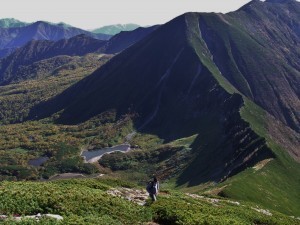 There is no feeling that can compare to walking on the top of a mountain ridge on a beautiful day, and nothing but wilderness spreading as far as the eye can see, the skies as blue as they will ever be, and absolutely no signs or sounds of civilization. Words cannot quite express and pictures cannot completely relate the experience. It was exhilarating. The landscape was unique, beautiful, and except for the few people in the distance, all ours.
There is no feeling that can compare to walking on the top of a mountain ridge on a beautiful day, and nothing but wilderness spreading as far as the eye can see, the skies as blue as they will ever be, and absolutely no signs or sounds of civilization. Words cannot quite express and pictures cannot completely relate the experience. It was exhilarating. The landscape was unique, beautiful, and except for the few people in the distance, all ours.
I find that the fact that mountains can be so scary makes them so awe-inspiring. Nature is at its most powerful here and can take us from the best to the worst of experiences – and back, just in a matter of hours. Just a week before, I was walking along the same ridge, with a visibility of a couple of meters, strong horizontal rain soaking most of my clothes, and a harsh wind chilling me to the bone. I was really hoping I would not encounter bears, who roam the mountains here. And with the fog, I have to admit, I was imagining them lurking around every corner. I was yanking my bear-bell like a crazy person. One of the two guys I crossed paths with had seven of these bear-bells, which made me feel considerably less crazy.
Mountains of Hidaka are not quite on the tourists` to-do lists, and even the most avid hikers have troubles getting there. The new restrictions and regulations make bookings couple of months in advance a necessity. That said, these are some of the most beautiful and majestic mountains in Japan. To get there, I first took a once-a-day bus to a small, one-street town of Furenai, from where I was intending to walk for 3-4 hours next day to an even smaller village, from where minibuses were taking people up to the hiking trail, a one-hour ride away. I stayed the night in a modified old train wagon. The lady who keeps that wagons (and manages the bus station and the produce market of the town, as I would find out later) was so nice and kindhearted, that upon hearing my plan, she called a friend who`s cousin drives the minibus. I got a free ride. Oh the joy!
The weather was pretty bad the first time around, and unsurprisingly all except one guy cancelled. I have cancelled for the same reason two years in a row, and it was now or never for me. Third year`s a charm. After a beautiful wide path in the canyon, passing a number of waterfalls, we reached the tricky part – the river itself. I was lucky I was not alone, because I had troubles finding the right places to cross the rapids, and the river was swelling up from all the rain. Two days later I was among the last people to make it back down, in increasingly bad weather, which turned out to be the typhoon that caused record floods in Japan. Enchanted by the little of scenery I managed to witness, but feeling defeated by the mountain which I could not fully experience or enjoy, I returned to the civilization.
A few days later the weather cleared up like nothing had happened. On a whim, for the first time in my life, I decided to risk it all, and went for this 4-day adventure again, without booking, and with company. It was our last chance, as the hiking season was nearing its end in late September. They let us go up. This time, it was a walk wordy of fairy-tales. We found our way across the sparkling river, and the next day hiked up the mountain laden with barriers and late-autumn flowers. Towards the end of our hike our luck ran out though, and due to an injury, we were still in the mountain come nightfall. We managed to appreciate the starlit sky exactly for one second before going back to crossing rivers in pitch-black conditions – survival mode on. Trying to find our way for a while, finally we followed tiny piles of stone, arranged here and there, letting us now we were on the path. We reached the cabin full of worried experienced Japanese hikers, who decided to stay up drinking while waiting and planning for our rescue. They wrapped us in blankets (yes, I fell in the river just before we reached the hut) and gave us a warm food and sweets. Once again we were showered by kindness.
I am so grateful for this wonderful experience. I am grateful for second chances. I am grateful for the wonderful people we met along the way. We managed to get a glimpse of the true heart of Hokkaido in all of its striking natural beauty. And most importantly, we encountered no bears.
About the Author: Biljana Novkovic, PhD in Environmental Science, moved to Japan for her graduate studies in 2008, and has since traveled in Asia whenever the opportunity presented itself. She loves hiking, traveling and writing.
Thank you for reading and commenting. Please enter our next Travel Writing competition and tell your story.
The post Japan: The Wilderness of Hokkaido appeared first on We Said Go Travel.
Argentina: The Mighty Waters
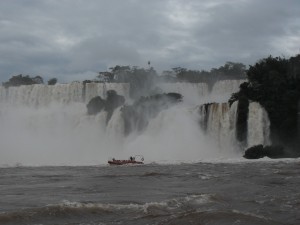 I felt the excitement building as we winged our way through a stunning sunset from Buenos Aires to Iguazu airport. The hotel set in lush sub-tropical gardens gave us a taste of what was to come.
I felt the excitement building as we winged our way through a stunning sunset from Buenos Aires to Iguazu airport. The hotel set in lush sub-tropical gardens gave us a taste of what was to come.
The next day our adventure began when a vehicle from the Lodge in the Yacutinga Reserve transported us from Puerto Iguazu into the depths of the Misiones Atlantic Rainforest. The driver put chains on the tyres as he negotiated the muddy roads through ‘yerba mate’ plantations, the rural communities and changing scenery.
Our room nestled in harmony with the surrounding jungle. Tangled vegetation, plants like orchids and bromeliads in the understory lower region we can see, lianas reaching for the sun, butterflies galore. As the forest canopy enclosed us, our senses were released to experience the secrets of this hidden world. Quieten your mind and the forest talks. A profusion of sounds of species I had never seen or heard before……………woodpeckers, humming birds,toucans, trogons, tanagers, interspersed with the eerie sound of black howler monkeys and at the night the myriad of frogs. Of course our expert guides, an ornithologist and local Guarani, had to patiently point out and impart just a little of their knowledge for us to see and understand a tiny fraction of the biodiversity of life in one of its richest expressions.
Life on the banks of the river can only be seen as you glide silently in your kayak through the water…………a Capybara family rushing into the stream, kingfishers diving for a meal, was that a Caiman?
After two days of wonder at every new sensation and sight, we had to leave this sanctuary. Not without incident ………..even chains on the wheels did not prevent us getting well and truly stuck in the mud! After all, this is a ‘rain’forest! Help was soon at hand and we were delivered safely in town, much to the relief of fellow passengers who had a flight to catch! Nothing prepared us for the awestruck wonder of the next two days………. visiting the Iguazu (Guarani for ‘great water’) Falls from the Argentina side and then the Brazil side. Four kilometres wide in all.
The falls lie within the Iguazu National Park, a UNESCO World Heritage Site. Our tour, called “The great adventure”, began as the truck travelled through the lush forest, the guide explaining our surroundings in detail in Spanish, which ‘sounded’ beautiful anyway! We waited in trepidation on the pier where we were to board the boat to navigate these tumultuous waters into the canyon below the falls. Our time had come! We donned our life jackets and off we set! Ready for some awe? As we rounded a bend we were faced with a moving, thunderous sheet of water gushing down from about 80 meters above us! A veil of mist rises creating a spectacular rainbow. We waited our turn to get up close and personal and be swept into the spray. Needless to say, our cameras were tucked away as we were happily drenched in this once-in-a-lifetime experience! Swifts, who nest behind the falls, were the only brave ones to venture closer! And the plants that manage to thrive as they cling to the rocks with tenacity. After landing we walked on shaky legs along the impressive walkways that extend across the top of the numerous falls that make up the Argentina section. Along the edges little coatis dig for tasty morsels, thrilling the children. Above the thundering roar of water you hear exclamations in many foreign languages as people gaze in awe.
There was more to explore the next day as we entered Brazil. Due to extensive rains inland, about 12 million tons of water flow over every second, the main walkway was closed but we did get amazing views where the Iguazu River plunges into a narrow gorge known as “the Devil’s Throat”. You definitely would not live to tell the tale if you took the plunge! I will be juggling superlatives if I try to tell you more. All too soon our awe-inspiring experience must end.
Memories are made of this.
About the Author: Moira Smart from South Africa. I have not had much overseas travel experience but my 3 trips to 3 different areas of Argentina and Chile over the past 3 years have been amazing! A senior citizen, working full-time.
Thank you for reading and commenting. Please enter our next Travel Writing competition and tell your story.
The post Argentina: The Mighty Waters appeared first on We Said Go Travel.
France: One Souffle At a Time

Anne, James Beard and Julia
We are honored to have an excerpt and share a review from One Soufflé at a Time: A Memoir of Food and France by Anne Willan and Amy Friedman. Amy Friedman is an award winning writer and will return in 2014 as one of the judges for our Inspiration Travel Writing Contest.
THINGS I’VE SMUGGLED IN MY SUITCASE
- Ginger biscuits for a midnight feast at my boarding school
- Exotic fruits and vegetables from Manaus on the Amazon, confiscated in Miami
- Fresh truffles for Julia Child, packed with camphor balls to distract sniffer dogs
- American bacon for the French chefs at La Varenne–so much crispier they said
- Trunks of American flour to France for testing recipes
- French Mars bars to the U.S.A. for the best hot chocolate sauce for the children
- Christmas gingerbread houses from America to France, if the roof collapses it still tastes the same
- Ypocras, a medieval spiced wine, labeled “spiced vinegar” so it can cross the state line
-A vinegar “mother” from Italy for our U.S kitchen
 From Chapter 7,
One Soufflé at a Time: A Memoir of Food and France
:
From Chapter 7,
One Soufflé at a Time: A Memoir of Food and France
:On a trip to South America, Mark said we must go to Buenos Aires in Argentina—one of the great cities of the world. There we took a touristy side trip to a gaucho ranch in the countryside where they put on a family-run barbecue, a churrasco. The meat had a gamey, heavy, fleshy smell, totally unlike anything I have ever come across before or since. It had been aged for goodness knows how long—two or three weeks, hanging almost in the open. They cooked it over slow-burning fires, and the flavor was totally unlike European or American beef, not gamey like venison, just tough and earthy, almost primeval.
I had to return home from that first South American trip before Mark was finished with his work in Rio de Janeiro, but he insisted that on my way I stop in Manaus a thousand miles up the Amazon River. On my own, I took a rickety, twice-weekly airplane flight. It was the rainy season, and the rivers were in full flood. I hired a boatman to take me down to the meeting of the black and yellow waters of a major Amazon tributary, and on the way back up river on turbulent water, we saw on land the most primitive tribe of people I have ever seen—they lived in hammocks with no shelter, classic Amazonian inhabitants who today almost certainly no longer exist. “We must be careful,” the boatman warned as we set food on the land. “Don’t try to talk to them or threaten them in any way.”
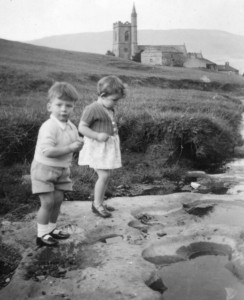
Anne in the Dales
I was to catch a plane that evening in Manaus and was jittery about making the flight, and as the little boat turned us upriver back to the town, the motor died, and I had one of my most harrowing moments on any journey. We were drifting rapidly downstream and away from the bank. No one knew where we were, or indeed of my presence in Manaus. For a few fraught minutes, I was terrified, but somehow the boatman finally managed to restart the engine. Back safely in the city, on my way to the airport I stopped at the market where all sorts of strange fruits and vegetables were on sale. I loaded up, but alas, everything was confiscated by Customs in Miami. That became a great lesson. Years later when, for instance, I wanted to bring fresh truffles from Paris to Julia Child in Boston, I packed them with camphor moth balls to distract the sniffer dogs.
Mark and I became more and more intrigued by South America and traveled to what then were considered faraway places—Ouro Preto in Brazil, Machu Picchu in Peru, and from there across Lake Titicaca; at 12,500 feet where only two fish native to the lake remain, we opted to eat rainbow trout, a species introduced in the ‘30s because Orestias and Trichomycterus were endangered. We traveled on, into Bolivia. We had an overnight cabin on a remarkable old chug chug English steamship with belle époque furnishings that, in the 19th century, had been sailed round Cape Horn, taken apart, carried on mule-back up the Andes and reassembled.
I still remember a fancy cracked china washbasin. Mark almost always found themes for our travels, a reason for going to various places. For instance, Ouro Preto excited our interest in colonial capitals which naturally led us to visit Quito in Ecuador, the oldest capital city of South America, 10,000 feet above sea level.
Mark taught me how to be truly adventurous.
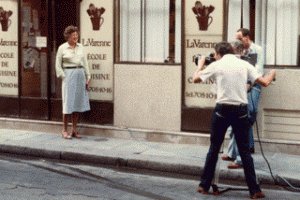
Anne and Julia in front of Le Fey
Read One Soufflé at a Time: A Memoir of Food and France by Anne Willan and Amy Friedman for of all the tasty tales!
From the New York Times Sunday Book Review, December 15, 2013 as reviewed by Christine Muehlke
Anne Willan must have gotten an advance copy of the Julia rules as a child in war-torn England. Rich, smart and determined, she was in thrall to the magic of French cuisine, which she learned at the London Cordon Bleu. This Cambridge economics grad was later disappointed by the instruction at the Paris original. And so, two charmed decades later, in 1975 — following stints cooking at Versailles and working at Gourmet magazine — she opened La Varenne cooking school on the Left Bank (and, later, in a Burgundy chateau). Among her advisers were her friends Julia Child and Simone Beck. Willan’s autobiography, ONE SOUFFLÉ AT A TIME: A Memoir of Food and France (St. Martin’s, $27.99), is a delightful sketch of four decades spent in the upper stratosphere of the food world. (The index includes more famous names than well-known recipes.) There’s a lifetime of stories to compress, which Willan’s co-author, Amy Friedman, does graciously. Willan’s noblesse and saltiness come through in equal measure. This is a strong woman who grabbed life by the babas: Imagine an Englishwoman opening a French cooking school — in Paris! — in the 1970s. In this age of the tell-all with recipes, it can be disappointing to only nick the surface (though we do learn why Willan and her husband refer to their lovemaking as “the call to prayer”). By the end, the anecdotes begin to read like a dictated Christmas letter, with Child’s death and the premiere of “Julie & Julia” occupying the same paragraph. But this life of a not quite first-generation culinary figure is worth discovering. ◆
The post France: One Souffle At a Time appeared first on We Said Go Travel.
New Zealand: The Daily Grind
My phone buzzing around 7.40am is the call to arms. The text comes through “walking this morning?” Whether I go or not, every morning at 8.00am a group of not-so-young women meet at the Khandallah Park swimming pool and begin their ascent. We are no Hillarys or Tenzings but the climb up Mt Kau Kau is no walk in the park, despite its location. It is a challenge for all of us though some are fitter than others.
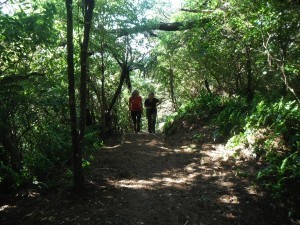 The track, in the heart of suburbia, transports us to the New Zealand bush as soon as we enter. Ferns, trees, moss and climbers mingle in their special configuration. As we walk birds sing and we spot white necked tuis and pretty fantails. The kererus whirr as they fly to perch on a branch and watch us pass. Seemingly unafraid of people it is no wonder they were almost wiped out when the Europeans settlers arrived.
The track, in the heart of suburbia, transports us to the New Zealand bush as soon as we enter. Ferns, trees, moss and climbers mingle in their special configuration. As we walk birds sing and we spot white necked tuis and pretty fantails. The kererus whirr as they fly to perch on a branch and watch us pass. Seemingly unafraid of people it is no wonder they were almost wiped out when the Europeans settlers arrived.
After a steep hill climb and several flights of wooden steps we reach farmland and wander across grassy fields in what I have dubbed the English section of the walk. As I traverse this part of the climb I imagine myself in Wainwright’s Lake District or the Pennines, although I know the gorse and bright blue sky belie this.
At various points along the way there is a clearing and we get a glimpse of the city. With its green hills and twinkling blue harbour it’s an impressive sight on a beautiful day. However our walks are not constrained by the weather and many the time we’ve battled our way up in wind, mist and rain with no hope of seeing anything once we got to the top.
The panorama of the city before us is the reward for the stiff climb and then comes the pleasure of descent. We scramble down a hill before clambering over the stile nicknamed the Hillary Step and re-entering the bush.
Now we’re in what some think is the most special part of the walk. With its dark trunked trees and heavy canopy this area of bush has a magical air to it and a hobbit or wizard wouldn’t seem out of place.
On Wednesdays we walk with gloves, not for the cold but because it’s Weedy Wednesday, the day we stop for 10 minutes on our way down to pull out the flourishing weeds clogging up the wooden steps.
A disparate group, we are united in our enjoyment of walking and appreciation of such a lovely place to walk on our doorstep. We chat as we trudge along, steepness of track and fitness permitting, and have come to know each other well.
Some days we don’t see anyone else but usually we see other regulars. On a nice day there are lots of people, enjoying the fresh air, the exercise and the bush. We see walkers and runners, old and young, fit and unfit, and lots of dogs. We’ve got to know the dogs as well as we know the owners and they love the freedom of romping up the track.
After our arrival back in Khandallah Park we sometimes stop for coffee – or sometimes not. We know that the next day most of us will be up again, enjoying the bush and the company as we complete our daily but pleasurable grind, the ascent of Mt Kau Kau.
About the Author: Clare Gleeson is a New Zealand historian, librarian and travel writer who enjoys exploring her own country as well as those further afield. She has a travel blog, wanderinghistorian.
The post New Zealand: The Daily Grind appeared first on We Said Go Travel.
We Said Go Travel
We Said Go Travel is a global community of over sixteen hundred writers with articles from every continent.
Stories are shared with photos and video from a perspective of the transformative power of travel. We Said Go Travel has hosted live and online events as well as travel writing contests around the world. ...more
- Lisa Niver's profile
- 57 followers



